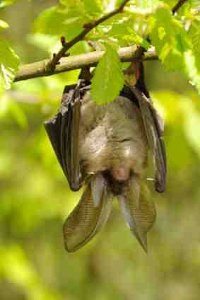|
Echolocation - A Way To See With SoundEcholocation (also known as biosonar), is the way insect-eating bats use sound (in the same way that we use vision) to navigate their way around in the dark and find food. Like the sound produced by a dog trainer
when s/he blows a dog whistle, echolocation calls can't usually be heard by humans.
The closer and/or more solid an object is, the louder the echo and the quicker it'll come back to me. And so a near by tree trunk will produce a louder echo than a paper bag that's further away. This is how I build a picture of where to fly and what to avoid. Although my echolocation shouts are loud, you won't be able to hear them without bat detectors because their main frequency (45 kHz) is outside the human hearing range (which is about 20 Hz to 20 kHz). Some species like the Horseshoe bat, make the calls through their noses, but most others are like me and do it through their mouths. (Some bats just have to be different, eh). Bats that echolocate through their noses tend to have a structure on their faces called a nose leaf. It's thought that this helps to direct the echolocating calls.
I detect moving objects like mosquitoes by making note of whether a particular echo comes from a different direction each time I receive it. The returned calls also tell me how big an object is. That's pretty handy, I wouldn't want to end up chasing a fox, thinking it was dinner! The closer I get to, let's say a mosquito, the faster and louder the echoes become until I gobble it up. If you listen to this on a bat detector, it can sound quite funny. A bit like someone blowing a raspberry :-) I'd like to catch a few more moths but they can hear my shouts and can avoid getting caught :-/ I sometimes wish I had bigger ears like the Brown long eared bat...

Their ear size means they can make quieter calls and still hear the echoes as they come back. Moths can't hear these whispers and so end up being dinner (or breakfast depending on how you look at it). Bat Detectors
|






